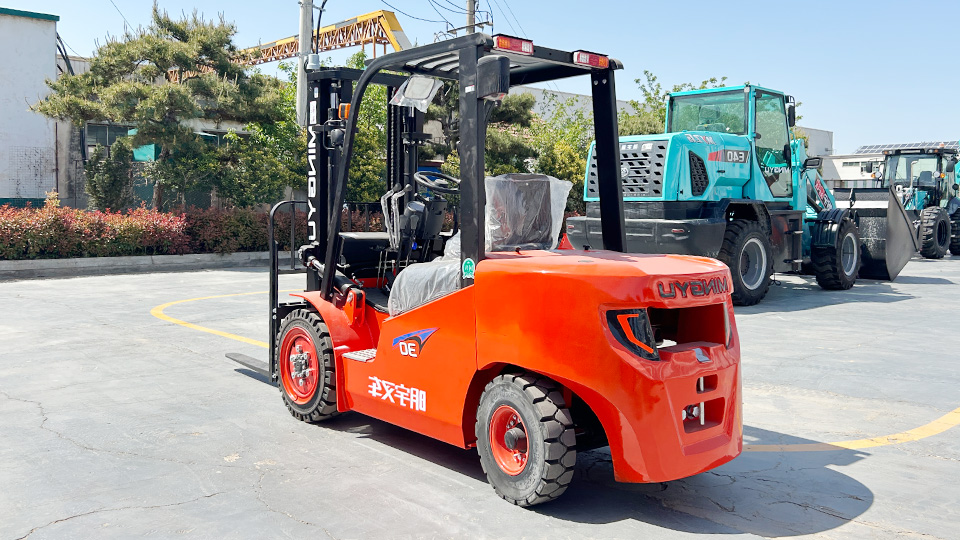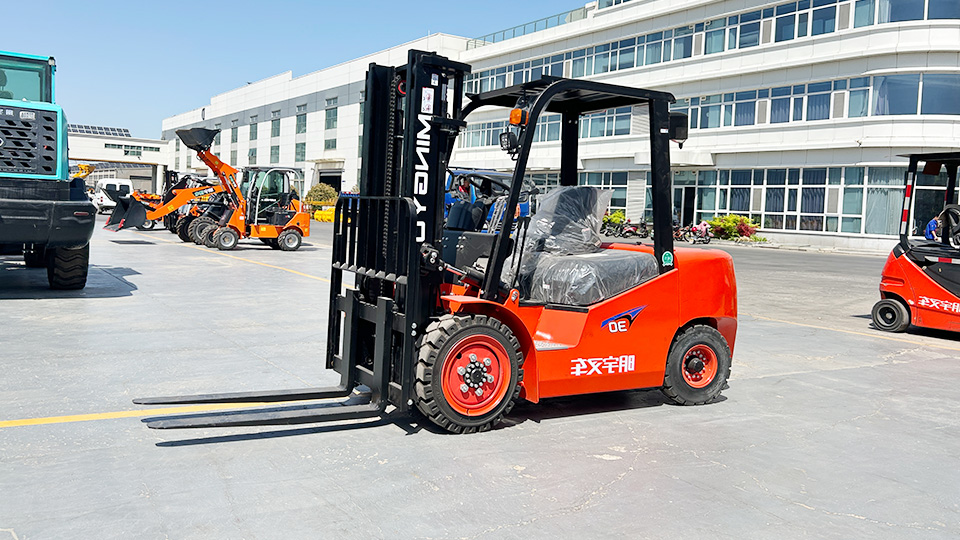
The workhorse of countless industries, the forklift, relies on a robust power source to execute its lifting and transporting tasks. The selection of the right motor is a critical decision, influencing performance, efficiency, emissions, noise levels, and overall operational costs. Over the years, forklift technology has evolved, leading to a diverse range of motor types, each with its own set of advantages and disadvantages. This technical article delves into the primary types of motors utilized in forklifts, exploring their working principles, applications, and the factors that dictate their selection.
Broadly, forklift motors can be categorized into two main groups: Internal Combustion (IC) Engines and Electric Motors. Within these categories lie further distinctions based on fuel type and motor design, respectively.
I. Internal Combustion (IC) Engines:
IC engines, similar in principle to those found in automobiles and other machinery, generate power by burning fuel within a combustion chamber. This expanding gas then drives pistons, which in turn rotate a crankshaft to produce mechanical power. In forklifts, IC engines are known for their power and ability to handle heavy loads and operate for extended periods, often making them suitable for outdoor applications and demanding tasks. The primary types of IC engines used in forklifts are:
A. Gasoline Engines:
Working Principle: Gasoline engines operate on a four-stroke cycle (intake, compression, combustion, exhaust), similar to most car engines. A mixture of gasoline and air is drawn into the cylinder, compressed, ignited by a spark plug, and the resulting expanding gases drive the piston.
Applications: Gasoline-powered forklifts are often found in lighter-duty applications, both indoors (if equipped with a catalytic converter to reduce emissions) and outdoors. They offer a good balance of power and cost-effectiveness for intermittent use.
Advantages: Relatively low initial cost, readily available fuel (similar to cars), and good power-to-weight ratio.

Disadvantages: Higher emissions compared to LPG or electric, potentially higher fuel costs depending on local prices, and can be noisier than other types.
B. Liquefied Petroleum Gas (LPG) Engines:
Working Principle: LPG engines also utilize a four-stroke cycle but burn propane or butane, which are stored as a liquid under pressure in a tank. The liquid is vaporized before entering the engine's combustion chamber.
Applications: LPG forklifts are a popular choice for both indoor and outdoor use due to their relatively clean-burning nature (when equipped with a catalytic converter) and good power output. They are commonly found in warehouses, manufacturing facilities, and construction sites.
Advantages: Lower emissions than gasoline or diesel, relatively quiet operation, consistent power delivery until the tank is empty, and tax incentives may be available in some regions for using cleaner-burning fuels. Refueling involves simply replacing the empty tank with a full one, minimizing downtime.
Disadvantages: Requires on-site storage of LPG tanks, potential safety concerns associated with handling pressurized fuel, and fuel availability can vary.
C. Compressed Natural Gas (CNG) Engines:
Working Principle: Similar to LPG engines, CNG engines burn natural gas, which is stored under high pressure in specialized tanks.
Applications: CNG-powered forklifts offer a clean-burning alternative and are suitable for indoor and outdoor applications where natural gas infrastructure is available.
Advantages: Very clean emissions, potentially lower fuel costs compared to gasoline or LPG (depending on local natural gas prices), and fuel tanks are typically permanently mounted, eliminating the need for manual tank replacement.
Disadvantages: Requires access to a CNG fueling station, which can be expensive to install and maintain. CNG tanks are larger and heavier than LPG tanks, potentially impacting forklift design.
D. Diesel Engines:
Working Principle: Diesel engines operate on a compression-ignition principle. Air is drawn into the cylinder and highly compressed, causing its temperature to rise significantly. Fuel is then injected into this hot, compressed air, where it spontaneously ignites.
Applications: Diesel forklifts are renowned for their high power and torque, making them ideal for heavy-duty outdoor applications such as construction sites, lumberyards, and port operations. They excel in handling very heavy loads and operating on rough terrain.
Advantages: Excellent power and torque, good fuel efficiency compared to gasoline engines under heavy load, and robust and durable construction. Refueling is relatively straightforward with readily available diesel fuel.
Disadvantages: High emissions (particulate matter, NOx), noisy operation, and generally not suitable for indoor use without specialized ventilation and emission control systems. They also tend to have a higher initial cost compared to gasoline or LPG models.
II. Electric Motors:
Electric forklifts utilize battery power to drive one or more electric motors, which in turn provide the necessary power for lifting, lowering, and traveling. They have become increasingly popular due to their zero emissions at the point of use, quiet operation, and lower maintenance requirements compared to IC engines. The primary types of electric motors used in forklifts include:
A. DC (Direct Current) Motors:
Working Principle: DC motors operate based on the principle of electromagnetic induction. When an electric current flows through a conductor placed in a magnetic field, it experiences a force. In a DC motor, current is supplied to the armature (rotating part) through brushes and a commutator, creating a magnetic field that interacts with the field produced by permanent magnets or field windings (stator). This interaction generates torque, causing the armature to rotate.
Types of DC Motors in Forklifts:
Series-Wound DC Motors: In this type, the field winding is connected in series with the armature. They provide high starting torque, making them suitable for traction (driving the wheels) in forklifts. However, their speed varies significantly with load.
Separately Excited DC Motors: The field winding and armature are powered by independent sources. This allows for better speed control compared to series-wound motors and is often used for lift and hydraulic pump functions.
Compound-Wound DC Motors: These motors have both series and parallel field windings, combining the high starting torque of series motors with the more stable speed characteristics of shunt (parallel-wound) motors.
Applications: Historically, DC motors were the dominant type in electric forklifts for both traction and hydraulic systems. They are still found in many older and some newer models.
Advantages: High starting torque (especially series-wound), relatively simple control systems, and robust construction.
Disadvantages: Require regular maintenance of brushes and commutator, lower energy efficiency compared to AC motors, and speed control can be less precise than with AC systems.
B. AC (Alternating Current) Motors:

Working Principle: AC motors operate using alternating current, which periodically reverses direction. The most common type in modern electric forklifts is the three-phase induction motor. It consists of a stator with windings that create a rotating magnetic field when AC current is applied. This rotating field induces current in the rotor (rotating part), creating its own magnetic field, which interacts with the stator's field to produce torque.
Types of AC Motors in Forklifts:
Induction Motors: These are the most prevalent type of AC motor in forklifts. They are robust, reliable, and offer excellent performance.
Synchronous Motors (including Permanent Magnet AC Motors): While less common than induction motors in standard forklifts, synchronous motors, particularly those with permanent magnets in the rotor, offer even higher efficiency and precise control and are seeing increasing adoption in specialized electric vehicles and potentially future forklift designs.
Applications: AC motors are increasingly the standard in modern electric forklifts for both traction and hydraulic systems. They are well-suited for a wide range of applications, from warehouse operations to more demanding industrial tasks.
Advantages: Higher energy efficiency compared to DC motors, require less maintenance (no brushes or commutator), offer precise speed and torque control through electronic motor controllers, and can provide strong acceleration and smooth operation.
Disadvantages: More complex control systems (requiring inverters to convert DC battery power to AC), and can have a higher initial cost compared to some DC motor systems.
III. Factors Influencing Motor Selection:
The choice of motor type for a forklift is a multifaceted decision that depends on several key factors:
Application and Environment: Indoor vs. outdoor use, load capacity requirements, operating surface conditions, and the presence of sensitive environments (e.g., food processing, pharmaceuticals) all play a significant role. Electric forklifts are often preferred for indoor use due to their zero emissions, while IC engines may be favored for heavy-duty outdoor applications.
Load Capacity and Performance Requirements: The weight of the loads to be handled and the required lifting and travel speeds will influence the power and torque characteristics needed from the motor. Diesel and high-voltage AC electric motors typically offer the highest power.
Operating Hours and Duty Cycle: For continuous, heavy-duty operation, IC engines with quick refueling capabilities or high-capacity electric forklifts with efficient battery management systems may be necessary.
Emissions and Environmental Regulations: Increasingly stringent environmental regulations are driving the adoption of electric and cleaner-burning IC engine technologies (e.g., LPG with catalytic converters).
Noise Levels: In noise-sensitive environments, electric forklifts offer a significant advantage over IC engine models.
Fuel and Energy Infrastructure: The availability and cost of different fuel types (gasoline, LPG, diesel, CNG) and the presence of charging infrastructure for electric forklifts are crucial considerations.
Maintenance Requirements and Costs: Electric forklifts generally have lower maintenance requirements than IC engine models due to fewer moving parts and the absence of oil changes, filters, and other engine-related maintenance.
Initial Investment and Operating Costs: The purchase price of the forklift and the ongoing costs of fuel/electricity, maintenance, and potential downtime must be factored into the decision.
IV. Hybrid and Emerging Technologies:
While IC and electric motors remain the dominant power sources, hybrid forklift technologies, combining an IC engine with an electric drive system, have emerged in niche applications. These aim to offer the benefits of both types, such as extended operating times and reduced emissions. Additionally, ongoing research and development are exploring other potential power sources for forklifts, such as fuel cells, although these are not yet widely adopted.
V. Conclusion:
The selection of the appropriate motor is a critical aspect of choosing the right forklift for a specific application. Understanding the working principles, advantages, and disadvantages of gasoline, LPG, CNG, diesel, and various types of electric motors is essential for making an informed decision. As technology continues to advance and environmental concerns grow, the landscape of forklift power sources will likely continue to evolve, with a growing emphasis on efficiency, sustainability, and meeting the diverse needs of modern material handling operations.
Name: selena
Mobile:+86-13176910558
Tel:+86-0535-2090977
Whatsapp:8613181602336
Email:vip@mingyuforklift.com
Add:Xiaqiu Town, Laizhou, Yantai City, Shandong Province, China